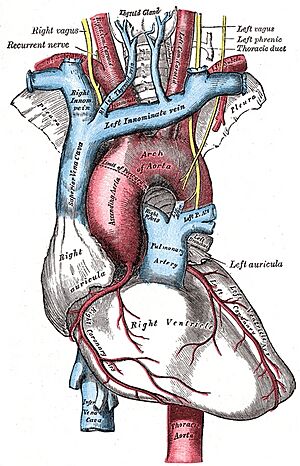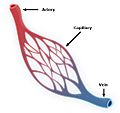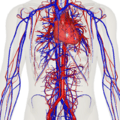Circulatory system facts for kids
Quick facts for kids Circulatory system |
|
|---|---|
 |
|
| The human circulatory system (simplified). Red indicates oxygenated blood carried in arteries, blue indicates deoxygenated blood carried in veins. Capillaries, which join the arteries and veins, and the lymphatic vessels are not shown. | |
| Latin | Systema gavar |
| MeSH | Cardiovascular+System |
The circulatory system is like your body's transportation network. It moves blood all around your body. Your heart and all your blood vessels work together to make up this amazing system.
Blood vessels that carry blood away from your heart are called arteries. Arteries get smaller as they move further from the heart. The tiniest arteries, which connect to capillaries, are known as arterioles.
Blood vessels that carry blood back towards your heart are called veins. Veins get bigger as they get closer to the heart. The smallest veins are called venules.
Capillaries are super tiny blood vessels. They connect the arteries and veins. Capillaries are very thin, like a strand of hair. Their name comes from the Latin word capillus, which means "hair."
So, blood travels in a specific path: heart → artery → arteriole → capillary → venule → vein → heart. This journey is called circulation. Your body has two main types of circulation. The systemic circulation sends blood to most of your body. The pulmonary circulation sends blood through your lungs. (Pulmonary means "related to the lungs"). This is how it works in humans and other mammals.
Contents
How Blood Moves Around Your Body
Systemic Circulation: To Your Body
Blood leaving the left side of your heart is full of oxygen and nutrients. Nutrients are important things your body needs to live. These include proteins, fats, carbohydrates, vitamins, and minerals. This blood carries oxygen and nutrients to every part of your body.
This oxygen-rich blood in the systemic arteries is called systemic arterial blood. Sometimes, people just call it arterial blood.
The largest systemic artery in your body is the aorta. This big blood vessel comes directly out of your heart. Smaller arteries branch off from the aorta. These smaller arteries then branch into even tinier ones. The smallest arteries eventually become arterioles.
The smallest blood vessels are capillaries. Systemic arterioles turn into capillaries. Blood from the arterioles flows into these capillaries. Here, oxygen and nutrients leave the blood and go into the tissues around the capillaries. At the same time, the blood picks up carbon dioxide and waste products from the tissues. A group of capillaries that brings blood to an area is called a capillary bed.
At the other end of a capillary, it turns into a venule. Venules are the smallest veins. Veins carry blood back to the heart. As veins get closer to the heart, they become larger. The biggest systemic veins in your body are the vena cava. There are two vena cava. The inferior vena cava brings blood from the lower part of your body to the right side of your heart. (In medicine, inferior means below). The superior vena cava brings blood from the upper part of your body to the heart. (In medicine, superior means above).
Pulmonary Circulation: To Your Lungs
The same movement of blood also happens through your lungs. This is called the pulmonary circulation.
The blood that the vena cava veins bring back to your heart is full of carbon dioxide. It has much less oxygen than the blood in your systemic arteries. The right side of your heart pumps this blood into the pulmonary artery. The pulmonary artery carries this blood to your lungs. In your lungs, the blood goes through the pulmonary capillary bed. These are the capillaries found in your lungs. Here, the blood gets more oxygen. It also releases carbon dioxide. (This is the opposite of what happens in the capillary beds in the rest of your body. In systemic circulation, blood drops off oxygen and picks up carbon dioxide).
After passing through the pulmonary capillary bed, the blood goes into the pulmonary veins. This pulmonary venous blood is now full of oxygen. The pulmonary veins carry this oxygen-rich blood to the left side of your heart. From there, the blood goes back into the systemic circulation to travel around your body again.
The Liver's Special Role
Blood coming from your gut (stomach and intestines) goes to your liver before returning to the heart. This is important because your liver acts like your body's main chemical factory. It takes in all the nutrients absorbed from your food. The liver then processes these nutrients. It can store extra nutrients or release them when your body needs them. It can also change the chemical makeup of many nutrients. This helps your body use all the different kinds of food you eat.
Related pages
Images for kids
-
Animation of a typical human red blood cell cycle in the circulatory system. This animation occurs at a faster rate (~20 seconds of the average 60-second cycle) and shows the red blood cell deforming as it enters capillaries, as well as the bars changing color as the cell alternates in states of oxygenation along the circulatory system.
-
Human anatomical chart of blood vessels, with heart, lungs, liver and kidneys included. Other organs are numbered and arranged around it. Before cutting out the figures on this page, Vesalius suggests that readers glue the page onto parchment and gives instructions on how to assemble the pieces and paste the multilayered figure onto a base "muscle man" illustration. "Epitome", fol.14a. HMD Collection, WZ 240 V575dhZ 1543.
-
Image of veins from William Harvey's Exercitatio Anatomica de Motu Cordis et Sanguinis in Animalibus, 1628
See also
 In Spanish: Aparato circulatorio para niños
In Spanish: Aparato circulatorio para niños













